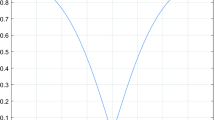Abstract
Feature reduction is one of the essential steps for machine learning applications. It reduces redundancy in the feature set, which reduces the computational cost in the learning phase. The success of the reduction stage depends on the size of the feature selected and the separability of the transformed matrix. In most of the work, the feature transformation matrix is determined mathematically and most of the time depends on eigenvectors and eigenvalues. If the feature space is high, it is difficult to calculate the eigen matrix in smaller devices. Hence, this work proposes a method to generate an optimum transformation matrix using heuristic optimization approach that leads to better classification accuracy with less feature size. This study uses Bhattacharyya distance as an objective function to evaluate the separability of the transformed feature matrix. Moreover, to select a proper subset of features, a penalty parameter is added with respect to number of features in transformation matrix. This work proposes a modified version of particle swarm optimization that can satisfy the objective. The study shows the ability to learn a transformation matrix with competitive results in classification task. The proposed method is evaluated on various freely available public datasets, namely Fisher’s IRIS, Wine, Wisconsin Breast Cancer, Ionosphere, Sonar, MNIST, NIT-R Bangla Numeral, and ISI-K Bangla Numeral datasets.
Access this chapter
Tax calculation will be finalised at checkout
Purchases are for personal use only
Similar content being viewed by others
References
Nayak, D.R., Dash, R., Majhi, B.: Automated diagnosis of multi-class brain abnormalities using MRI images: a deep convolutional neural network based method. Pattern Recogn. Lett. 138, 385–391 (2020)
Kumar, R.L., Kakarla, J., Isunuri, B.V., Singh, M.: Multi-class brain tumor classification using residual network and global average pooling. Multimedia Tools Appl. 80(9), 13429–13438 (2021)
Mishra, S., Mishra, S.K., Majhi, B., Sa, P.K.: 2d-dwt and Bhattacharyya distance based classification scheme for the detection of acute lymphoblastic leukemia. In: 2018 International Conference on Information Technology (ICIT), 2018 International Conference on Information Technology (ICIT), pp. 61–67 (2018)
Ali, F., El-Sappagh, S., Islam, S.R., Kwak, D., Ali, A., Imran, M., Kwak, K.S.: A smart healthcare monitoring system for heart disease prediction based on ensemble deep learning and feature fusion. Inform. Fusion. 63, 208–222 (2020)
Kianat, J., Khan, M.A., Sharif, M., Akram, T., Rehman, A., Saba, T.: A joint framework of feature reduction and robust feature selection for cucumber leaf diseases recognition. Optik 240, 166566 (2021)
Aghdam, M.H., Ghasem-Aghaee, N., Basiri, M.E.: Text feature selection using ant colony optimization. Expert Syst. Appl. 36(3, Part 2), 6843–6853 (2009)
Maćkiewicz, A., Ratajczak, W.: Principal components analysis (PCA). Comput. Geosci. 19(3), 303–342 (1993)
Bhattacharyya, A.: On a measure of divergence between two statistical populations defined by their probability distributions. Bull. Calcutta Math. Soc. 35, 99–109 (1943)
Kailath, T.: The divergence and bhattacharyya distance measures in signal selection. IEEE Trans. Commun. Technol. 15(1), 52–60 (1967)
De Maesschalck, R., Jouan-Rimbaud, D., Massart, D.L.: The Mahalanobis distance. Chemom. Intell. Lab. Syst. 50(1), 1–18 (2000)
Abualigah, L.M., Khader, A.T., Hanandeh, E.S.: A new feature selection method to improve the document clustering using particle swarm optimization algorithm. J. Comput. Sci. 25, 456–466 (2018)
Author information
Authors and Affiliations
Corresponding author
Editor information
Editors and Affiliations
Rights and permissions
Copyright information
© 2022 The Author(s), under exclusive license to Springer Nature Singapore Pte Ltd.
About this paper
Cite this paper
Das, D., Prusty, S., Swain, B., Sharma, T. (2022). Evaluation of Optimal Feature Transformation Using Particle Swarm Optimization. In: Dehuri, S., Prasad Mishra, B.S., Mallick, P.K., Cho, SB. (eds) Biologically Inspired Techniques in Many Criteria Decision Making. Smart Innovation, Systems and Technologies, vol 271. Springer, Singapore. https://doi.org/10.1007/978-981-16-8739-6_19
Download citation
DOI: https://doi.org/10.1007/978-981-16-8739-6_19
Published:
Publisher Name: Springer, Singapore
Print ISBN: 978-981-16-8738-9
Online ISBN: 978-981-16-8739-6
eBook Packages: Intelligent Technologies and RoboticsIntelligent Technologies and Robotics (R0)




